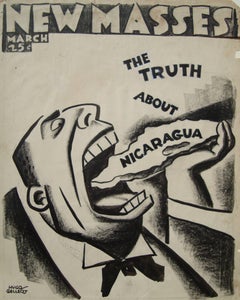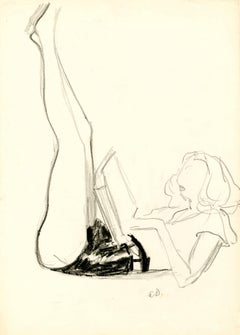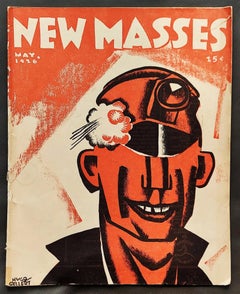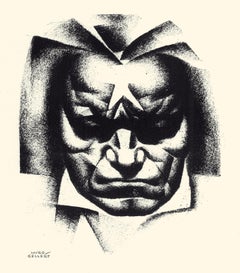Hugo Gellert Art
to
1
Overall Width
to
Overall Height
to
1
1
1
1
1
1
1
1
1
1
8,917
2,810
2,504
1,337
1
Artist: Hugo Gellert
Study for "The New Masses"
By Hugo Gellert
Located in Boston, MA
Hugo Gellert (Hungarian-American, 1892-1985), Study for "The New Masses". Mary Ryan Gallery 4. Signed in ink lower left: "Hugo / Gellert"; inscribed in crayo...
Category
20th Century American Realist Hugo Gellert Art
Materials
Ink, Wax Crayon
Related Items
Eileen Lake
By Adolf Arthur Dehn
Located in Fairlawn, OH
Eileen Lake
Crayon on paper, early1930's
Initialed in pencil lower right (see photo)
Titled and annotated verso "Eileen Lake, early 1930s girlfriend"
Note: Eileen Hall Lake was an American poet and Adolf Dehn's girlfriend in the early 1930s.
Provenance:
Estate of the artist
By descent
Adolf Dehn, American Watercolorist and Printmaker, 1895-1968
Adolf Dehn was an artist who achieved extraordinary artistic heights, but in a very particular artistic sphere—not so much in oil painting as in watercolor and lithography. Long recognized as a master by serious print collectors, he is gradually gaining recognition as a notable and influential figure in the overall history of American art.
In the 19th century, with the invention of the rotary press, which made possible enormous print runs, and the development of the popular, mass-market magazines, newspaper and magazine illustration developed into an artistic realm of its own, often surprisingly divorced from the world of museums and art exhibitions, and today remains surprisingly overlooked by most art historians. Dehn in many regards was an outgrowth of this world, although in an unusual way, since as a young man he produced most of his illustrative work not for popular magazines, such as The Saturday Evening Post, but rather for radical journals, such as The Masses or The Liberator, or artistic “little magazines” such as The Dial. This background established the foundation of his outlook, and led later to his unique and distinctive contribution to American graphic art.
If there’s a distinctive quality to his work, it was his skill in introducing unusual tonal and textural effects into his work, particularly in printmaking but also in watercolor. Jackson Pollock seems to have been one of many notable artists who were influenced by his techniques.
Early Years, 1895-1922
For an artist largely remembered for scenes of Vienna and Paris, Adolf Dehn’s background was a surprising one. Born in Waterville, Minnesota, on November 22, 1895, Dehn was the descendent of farmers who had emigrated from Germany and homesteaded in the region, initially in a one-room log cabin with a dirt floor. Adolf’s father, Arthur Clark Dehn, was a hunter and trapper who took pride that he had no boss but himself, and who had little use for art. Indeed, during Adolf’s boyhood the walls of his bedroom and the space under his bed were filled with the pelts of mink, muskrats and skunks that his father had killed, skinned and stretched on drying boards. It was Adolf’s mother, Emilie Haas Dehn, a faithful member of the German Lutheran Evangelical Church, who encouraged his interest in art, which became apparent early in childhood. Both parents were ardent socialists, and supporters of Eugene Debs. In many ways Dehn’s later artistic achievement was clearly a reaction against the grinding rural poverty of his childhood.
After graduating from high school in 1914 at the age of 19—an age not unusual in farming communities at the time, where school attendance was often irregular—Dehn attended the Minneapolis School of Art from 1914 to 1917, whose character followed strongly reflected that of its director, Munich-trained Robert Kohler, an artistic conservative but a social radical. There Dehn joined a group of students who went on to nationally significant careers, including Wanda Gag (later author of best-selling children’s books); John Flanagan (a sculptor notable for his use of direct carving) Harry Gottlieb (a notable social realist and member of the Woodstock Art Colony), Elizabeth Olds (a printmaker and administrator for the WPA), Arnold Blanch (landscape, still-life and figure painter, and member of the Woodstock group), Lucille Lunquist, later Lucille Blanch (also a gifted painter and founder of the Woodstock art colony), and Johan Egilrud (who stayed in Minneapolis and became a journalist and poet).
Adolf became particularly close to Wanda Gag (1893-1946), with whom he established an intense but platonic relationship. Two years older than he, Gag was the daughter of a Bohemian artist and decorator, Anton Gag, who had died in 1908. After her husband died, Wanda’s mother, Lizzi Gag, became a helpless invalid, so Wanda was entrusted with the task of raising and financially supporting her six younger siblings. This endowed her with toughness and an independent streak, but nonetheless, when she met Dehn, Wanda was Victorian and conventional in her artistic taste and social values. Dehn was more socially radical, and introduced her to radical ideas about politics and free love, as well as to socialist publications such as The Masses and The Appeal to Reason.
Never very interested in oil painting, in Minneapolis Dehn focused on caricature and illustration--often of a humorous or politically radical character. In 1917 both Dehn and Wanda won scholarships to attend the Art Students League, and consequently, in the fall of that year both moved to New York. Dehn’s art education, however, ended in the summer of 1918, shortly after the United States entered World War I, when he was drafted to serve in the U. S. Army. Unwilling to fight, he applied for status as a conscientious objector, but was first imprisoned, then segregated in semi-imprisonment with other Pacifists, until the war ended. The abuse he suffered at this time may well explain his later withdrawal from taking political stands or making art of an overtly political nature. After his release from the army, Dehn returned to New York where he fell under the spell of the radical cartoonist Boardman Robinson and produced his first lithographs. He also finally consummated his sexual relationship with Wanda Gag.
The Years in Europe: 1922-1929
In September of 1921, however, he abruptly departed for Europe, arriving in Paris and then moving on to Vienna. There in the winter of 1922 he fell in love with a Russian dancer, Mura Zipperovitch, ending his seven-year relationship with Wanda Gag. He and Mura were married in 1926. It was also in Vienna that he produced his first notable artistic work.
Influenced by European artists such as Jules Pascin and Georg Grosz, Dehn began producing drawings of people in cafes, streets, and parks, which while mostly executed in his studio, were based on spontaneous life studies and have an expressive, sometimes almost childishly wandering quality of line. The mixture of sophistication and naiveté in these drawings was new to American audiences, as was the raciness of their subject matter, which often featured pleasure-seekers, prostitutes or scenes of sexual dalliance, presented with a strong element of caricature. Some of these drawings contain an element of social criticism, reminiscent of that found in the work of George Grosz, although Dehn’s work tended to focus on humorous commentary rather than savagely attacking his subjects or making a partisan political statement. Many Americans, including some who had originally been supporters of Dehn such as Boardman Robinson, were shocked by these European drawings, although George Grocz (who became a friend of the artist in this period) admired them, and recognized that Dehn could also bring a new vision to America subject matter. As he told Dehn: “You will do things in America which haven’t been done, which need to be done, which only you can do—as far at least as I know America.”
A key factor in Dehn’s artistic evolution at this time was his association with Scofield Thayer...
Category
1930s American Realist Hugo Gellert Art
Materials
Oil Crayon
"Dragon, " Original Pastel Drawing
By Quang Ho
Located in Denver, CO
"Dragon," by Quang Ho, is a secondary market work with one previous owner. It is signed and dated (1988) on the lower left. The painting comes with it's original frame (measures 50 x...
Category
20th Century American Realist Hugo Gellert Art
Materials
Paper, Pastel
NYC Subway Mid 20th Century American Scene Social Realism WPA Modern 1930s
By Daniel Ralph Celentano
Located in New York, NY
NYC Subway Riders Mid 20th Century American Scene Social Realism WPA Modern 1930s
Daniel Celentano (1902 - 1980)
Subway Scene, 1930s
8 x 9 inches
Ink and wash on paper
Singed lower ...
Category
1930s American Realist Hugo Gellert Art
Materials
Paper, Ink, Gouache
Untitled (Joe Louis knocking out Max Schmeling in 1938 rematch)
By Fletcher Martin
Located in Fairlawn, OH
Untitled
(Joe Louis knocking out Max Schmeling in 1938 rematch)
Pen and ink with wash on heavy wove sketchbook paper, 1938
Signed lower right: Fletcher Martin
Directly related to Martin's famous painting of 1942 entitled "Lullaby", which was also used in the lithograph of the same name. (see photo)
The drawing depicts the third and final knockdown of Max Schmeling in their rematch of 1938.
Condition: Mat staining at the edges of the sketchbook page edges
Toning to verso from previous framing.
Does not affect framed presentation
"It was here that Louis first used sport to bridge America's cavernous racial divide. With Hitler on the march in Europe and using Schmeling's victory over Louis as proof of “Aryan supremacy,” anti-Nazi sentiment ran high in the States. Louis had long grown accustomed to the pressures of representing his race but here the burdens were broader and deeper. Now he was shouldering the hopes of an entire nation.
A few weeks before the match Louis visited the White House and U.S. President Franklin Delano Roosevelt, whose tenure lasted even longer than Louis' would, told him, “Joe, we need muscles like yours to beat Germany.”
Those muscles certainly beat Schmeling on fight night...
Category
1930s American Realist Hugo Gellert Art
Materials
Ink
$4,000
H 13.5 in W 9.75 in
Two Monkeys
By Lynn Gertenbach
Located in San Francisco, CA
This artwork "Two Monkeys) is an original ink drawing on thick Bristol paper by American artist Lynn Gertenbach, b.1940. It is hand signed at the lower rig...
Category
Late 20th Century American Realist Hugo Gellert Art
Materials
India Ink
"Good Health Week" American Scene Modern Social Realism Mid 20th Century WPA Era
By Jo Cain
Located in New York, NY
"Good Health Week" American Scene Modern Social Realism Mid- 20th Century WPA Era
Jo Cain (1904 – 2003)
Good Health Week – b/w
10 ½ x 15 1/2 inches
I...
Category
1930s American Realist Hugo Gellert Art
Materials
Paper, Ink
Two Reclining Nudes, Raphael Soyer
By Raphael Soyer
Located in Fairfield, CT
Artist: Raphael Soyer (1899-1987)
Title: Two Reclining Nudes
Year: Circa 1987
Medium: Watercolor & Pencil Drawing on Archival paper
Size: 17 x 14 inches
Condition: Excellent
Inscript...
Category
1980s American Realist Hugo Gellert Art
Materials
Pastel, Graphite
TOBACCO ROAD Mid 20th Century Realism 1940 Drawing from the Novel WPA Literary 2
By David Fredenthal
Located in New York, NY
TOBACCO ROAD Mid 20th Century Realism 1940 Drawing from the Novel WPA Literary 2
10 1/2 x 6 (sight), Signed David Fredenthal lower right. Framed by Lowy....
Category
1930s American Realist Hugo Gellert Art
Materials
Paper, Ink, Watercolor
$12,500
H 21 in W 16 in D 2 in
Androscoggin River Falls, study for The Manufacturers National Bank of Lewiston-
By Dean Cornwell
Located in Miami, FL
If there ever were a perfect work in the canon of art history, this masterpiece study by Dean Cornwell would be it. Every line has meaning and not a line out of place, as Cornwell d...
Category
1950s American Realist Hugo Gellert Art
Materials
Pastel
$145,000
H 30 in W 52.5 in
Two Children and Dog
By Lynn Gertenbach
Located in San Francisco, CA
This artwork "Two Children with Dog" is an original ink drawing on vey thick Bristol paper by American artist Lynn Gertenbach, b.1940. It is hand signed a...
Category
Late 20th Century American Realist Hugo Gellert Art
Materials
India Ink
Ford T
By Lynn Gertenbach
Located in San Francisco, CA
This artwork "Ford T" is an original ink drawing and gouache on thick Bristol paper by American artist Lynn Gertenbach, b.1940. It is hand signed at the lower left corner by the arti...
Category
Late 20th Century American Realist Hugo Gellert Art
Materials
India Ink
Fillmore East 1968 Traffic, Blue Cheer, Iron Butterfly original artwork
By David Edward Byrd
Located in Southampton, NY
This is the original character study art for the very first Fillmore East concert Poster by David Edward Byrd in 1968, it is featured on page 74 of the new coffee table book "Poster Child, The Psychedelic Art and Technicolor Life of David Edward Byrd". The poster was for a concert at the Fillmore East featuring, Traffic, Blue Cheer and Buttery. An image of the finished poster is shown in this listing just for reference to the figures. David Edward Byrd created some of the most important and memorable Classic Theatre and Rock and Roll images from the 1960s and 70s. David created ALL of the Art for Bill Graham’s Fillmore East, including their Program covers and Rock posters, the art for Jimi Hendrix’s first Fillmore East appearance, The Rolling Stones 1969 World Tour art, The Who’s Performance of Tommy at the New York Metropolitan Opera House and The Fillmore, and The Grateful Dead Swell Dance Concert to name only a few. He also created the poster art for the original location of the 1969 Woodstock music festival . His memorable images were also used for classic Broadway shows like Godspell, Follies and Jesus Christ Superstar to mention only a few. A new coffee table book titled "Poster Child, The Psychedelic Art & Technicolor Life of David Edward Byrd" features his classic Rock and Roll art and Broadway art...
Category
1960s American Realist Hugo Gellert Art
Materials
Ink, Watercolor, Vellum, Pencil
$3,800
H 18 in W 16 in D 2 in
Previously Available Items
"New Masses" Vol 1, No 1, May 1926, Actual Magazine, VG Condition Hugo Gellert
By Hugo Gellert
Located in New York, NY
"New Masses" Vol 1, No 1, May 1926, Actual Magazine, VG Condition Hugo Gellert
New Masses Magazine. May 1926, Inaugural: Vol 1, No 1. Published by the New Masses Inc., 39 West 8th St., New York City.
New Masses (1926-1948) was an American Marxist magazine launched in New York City. It was closely associated with the Communist Party USA. With the coming of the Great Depression in 1929 America became more receptive to ideas from the political Left and New Masses became highly influential in intellectual circles. The magazine has been called the principal organ of the American cultural left from 1926 onwards. It featured the work of an array of independent writers and artists.
The Metropolitan Museum of Art’s recent exhibition, “Art for the Millions: American Culture and Politics in the 1930s” celebrated the American spirit during the depression era. In the exhibition several issues of "New Masses" are exhibited, but not Vol 1. No. 1. We offer that.
Lithograph by Hugo Gellert on the cover and multiple illustrations in magazine. Hugo Gellert (1892-1985) was a Hungarian-American illustrator and muralist. A committed radical and member of the Communist Party of America, Gellert is considered by some art critics as among the best political work of the first half of the 20th century.
The artists who works are inside Vol 1, No. 1 include: William Gropper, Adolph Dehn, Stuart Davis, Art Young, I. Klein, Boardman Robinson, Wanda Gag, Louis Lozowick, F. S. Hynd, New Masses, Otto Soclow, Hans Stengel and Arnold Ronnebeck.
The writers included in this issue: Babette Deutsch, Robert Dljnn, Robinson Jeffers, William Carlos Williams, Nathan Asch, Norman Studer, M. H. Hedges, Art Shields, Karol Rembov, Hal Saunders-White, Edwin Seaver, George Sterling, Scott Nearing and Whittaker Chambers.
Editors: Egmont Arens, Joseph Freeman, Hugo Gellert, Michael Gold, James Rorty, and Joan Sloan.Executive Board: Egmont Arens, Maurice Becker, Helen Black, John Dos Passos, Robert Dunn...
Category
1920s American Modern Hugo Gellert Art
Materials
Paper
Ludwig Van Beethoven
By Hugo Gellert
Located in Myrtle Beach, SC
A fine, richly-inked impression, on cream laid paper; the full sheet (19 3/4 x 16 inches) with wide margins, in excellent condition. Signed in pencil, lower left. Scarce.
A powerfu...
Category
1920s American Modern Hugo Gellert Art
Materials
Lithograph
MODERN SCIENCE FOR ALL
By Hugo Gellert
Located in Santa Monica, CA
HUGO GELLERT (1892 - 1985)
MODERN SCIENCE FOR ALL, 1943
Screenprint, signed in pencil lower left. Edition 54. Image 15 x 13 inches. Full margins,
fold...
Category
1940s American Modern Hugo Gellert Art
Materials
Screen
FREE MAN'S DUTIES, No 4
By Hugo Gellert
Located in Santa Monica, CA
HUGO GELLERT (1892 - 1985)
FREE MAN'S DUTIES N0. 4
Screenprint, signed in pencil lower left. Edition 54. Image 15 x 13 inches. Full margins,
folded sh...
Category
1940s American Modern Hugo Gellert Art
Materials
Screen
Hugo Gellert art for sale on 1stDibs.
Find a wide variety of authentic Hugo Gellert art available for sale on 1stDibs. You can also browse by medium to find art by Hugo Gellert in crayon, ink, paper and more. Much of the original work by this artist or collective was created during the 20th century and is mostly associated with the modern style. Not every interior allows for large Hugo Gellert art, so small editions measuring 11 inches across are available. Customers who are interested in this artist might also find the work of Emil Bisttram, George Biddle, and Frank Wootton. Hugo Gellert art prices can differ depending upon medium, time period and other attributes. On 1stDibs, the price for these items starts at $2,950 and tops out at $8,250, while the average work can sell for $5,600.




